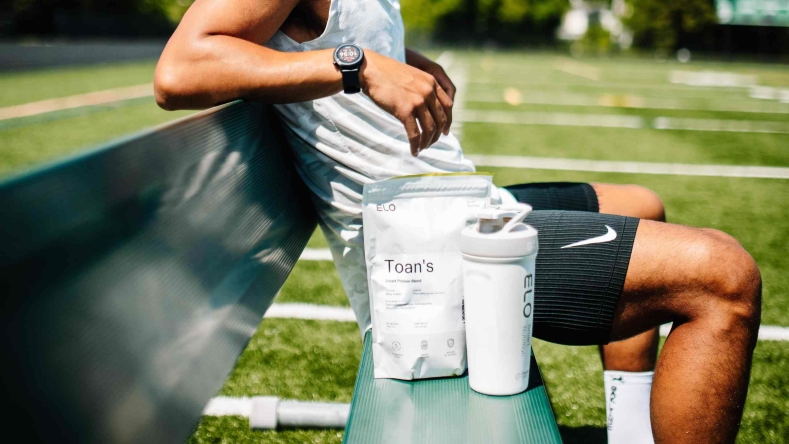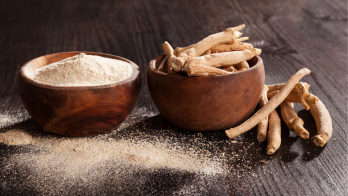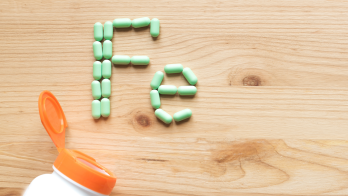Science-backed GLP-1 supplements
If you’re looking to lose weight or improve blood sugar, you may have heard of GLP-1. But what is GLP-1, and is it right for you? From health benefits to precautionary tales, here’s what science has to say about GLP-1 supplements.

When it comes to losing weight, experts continue to agree that this complex topic goes far beyond your caloric consumption. And while diet and exercise remain foundational pillars for weight loss, the complexities of individual metabolisms and genetic predispositions may warrant additional interventions. This has led to the use of GLP-1 supplements and medications as complementary measures to enhance weight loss and blood sugar management. But what exactly are GLP-1 supplements, and do they actually work?
In this article, we’re digging into the science behind GLP-1 to better understand its influence on weight and blood sugar, and explore the potential benefits that certain supplements may offer.
What is GLP-1?
Glucagon-like peptide 1 (GLP-1) is a naturally-occurring hormone made in the small intestine, and plays a role in regulating blood sugar levels, increasing satiety, and slowing stomach emptying - all of which can help with weight loss [ 1 2
While your body naturally produces GLP-1, you can also get GLP-1 agonists in certain medications, which are designed to regulate blood sugar levels and boost satiety. These medications operate by mimicking the actions of GLP-1, and have been used to treat type 2 diabetes and, in some cases, obesity [ 3
Science-backed GLP-1 supplements
While you can be prescribed specific GLP-1 medications, certain supplements may also prove beneficial for glucose levels and weight loss. Here’s what science has to say about the best GLP-1 supplements.

Protein
Protein 4 5 6
While protein is most often known for its beneficial effects on muscle mass and satiety, emerging research suggests that daily protein supplements (when combined with calcium) may enhance the metabolic effects of GLP-1 [ 7 8 9
Dosing
The current RDA for protein is as follows:
Adults 18 - 65 years old: 0.8 g/kg of body weight/day [
10
]Adults over 65 years old: 1 to 1.2 g/kg of body weight/day [
11
]Athletes or highly active individuals: 1.2-2.0 g/kg of body weight/day, depending on training needs and goals [
12
]
You can find protein in lean meats (like chicken and turkey), seafood, peas, Greek yogurt, soyfoods, beans, and protein powders, such as Elo Smart Protein

Curcumin
Curcumin 13
Emerging studies have also found that curcumin could have anti-glycemic effects since it may induce GLP-1 and improve glucose control [ 14 15
Dosing
There is no standard dose; however, the World Health Organization (WHO) has established 1.4 mg of curcumin/pound of body weight (0–3 mg/kg) as an acceptable daily intake [ 16
You can find curcumin in Elo Smart Gummies
Precautions
You should avoid taking turmeric supplements if you [ 17
Are pregnant or breastfeeding
Have diabetes, gallstones, gallbladder or kidney disease, bleeding disorders, or immunity problems
Will undergo surgery
Before adding curcumin to your routine, check with your doctor or dietitian to see if supplementation is right for you.

Ginseng
Ginseng is one of the most popular herbal medicines, and has been used in Chinese and alternative medicine for centuries. While there are many varieties, Asian ginseng (Panax ginseng or Korean ginseng) and American ginseng (Panax quinquefolius) are the most common and widely used.
Ginseng is well-known for its ability to enhance physical and emotional health and increase energy [ 18 19 20
Dosing
While there is no RDA for ginseng, most research studies suggest daily doses of 200 milligrams of ginseng extract or 0.5-2 grams of dry root. When given as a capsule, dosages of ginseng usually range from 100-600 milligrams a day [ 21
You can find ginseng in Elo Smart Gummies
Precautions
Ginseng is generally well tolerated and considered safe to take in low-to-moderate amounts. However, a common side effect of American ginseng is headache, whereas difficulty sleeping is more common with Asian ginseng [ 22 23
Before adding ginseng to your routine, check with your doctor or dietitian to see if supplementation is right for you.

Berberine
Berberine 24 24 24
In addition to these benefits, research shows that berberine may play a role in improving symptoms of diabetes, as it has been found to induce GLP-1 secretion in the intestine and reduce hyperglycemia [ 25 26
Dosing
Berberine doses typically range from 400-1,500 mg/day [ 27 27
Berberine is available in various forms, including capsules, tablets, powders, gels, and liquid extracts.
Precautions
While berberine supplements may provide health benefits, they may not be right for everyone. It’s recommended to avoid supplementation if you are pregnant, breastfeeding, and/or take certain medications for diabetes, high blood pressure, blood clotting, and cholesterol management [ 27
Before adding berberine to your routine, check with your doctor or dietitian to see if supplementation is right for you.
Summary
Whether you’re looking to lose weight, improve blood sugar levels, or boost your health, experts continue to agree that diet and lifestyle choices are paramount. However, the use of GLP-1 supplements (such as protein, berberine, ginseng, and curcumin) and specific medications may improve blood sugar, boost weight loss, and enhance satiety, which can prove beneficial when treating type 2 diabetes and obesity.
Disclaimer: The text, images, videos, and other media on this page are provided for informational purposes only and are not intended to treat, diagnose or replace personalized medical care.
Key takeaways
Glucagon-like peptide 1 (GLP-1) is a naturally-occurring hormone made in the small intestine, and plays a role in regulating blood sugar levels, increasing satiety, and slowing stomach emptying.
Protein, berberine, ginseng, and curcumin are science-backed GLP-1 supplements that have beneficial effects on blood sugar and satiety.
Before adding a new GLP-1 supplement or medication to your routine, talk with your healthcare provider to see if it’s right for you.
References
professional, C. C. medical. (n.d.). GLP-1 agonists. Cleveland Clinic.
https://my.clevelandclinic.org/health/treatments/13901-glp-1-agonists
Examine.com. (2023, December 18). Glucagon-like peptide 1 (GLP-1): How diet, lifestyle, and supplements may provide benefits. Examine.
https://examine.com/outcomes/glp-1/
Glucagon-like peptide-1 receptor agonists - statpearls - NCBI BOOKSHELF. (n.d.).
https://www.ncbi.nlm.nih.gov/books/NBK551568/
Carbone, J. W., & Pasiakos, S. M. (2019). Dietary Protein and Muscle Mass: Translating Science to Application and Health Benefit. Nutrients, 11(5), 1136.
https://doi.org/10.3390/nu11051136
Morell, P., & Fiszman, S. (2017). Revisiting the role of protein-induced satiation and satiety. Food Hydrocolloids, 68, 199–210.
https://doi.org/10.1016/j.foodhyd.2016.08.003
Ogilvie, A. R., Schlussel, Y., Sukumar, D., Meng, L., & Shapses, S. A. (2022). Higher protein intake during caloric restriction improves diet quality and attenuates loss of Lean Body Mass. Obesity, 30(7), 1411–1419.
https://doi.org/10.1002/oby.23428
Mietlicki-Baase, E. G., Koch-Laskowski, K., McGrath, L. E., Krawczyk, J., Pham, T., Lhamo, R., Reiner, D. J., & Hayes, M. R. (2017). Daily supplementation of dietary protein improves the metabolic effects of GLP-1-based pharmacotherapy in lean and obese rats. Physiology & behavior, 177, 122–128.
https://doi.org/10.1016/j.physbeh.2017.04.017
Watkins, J. D., Koumanov, F., & Gonzalez, J. T. (2021). Protein- and calcium-mediated GLP-1 secretion: A narrative review. Advances in Nutrition, 12(6), 2540–2552.
https://doi.org/10.1093/advances/nmab078
Rao, M., Zumbro, E. L., Broughton, K. S., & LeMieux, M. J. (2021). Whey protein preload enhances the active GLP-1 response and reduces circulating glucose in women with polycystic ovarian syndrome. Nutrition research (New York, N.Y.), 92, 84–98.
https://doi.org/10.1016/j.nutres.2021.06.005
Baum, J. I., Kim, I. Y., & Wolfe, R. R. (2016). Protein Consumption and the Elderly: What Is the Optimal Level of Intake?. Nutrients, 8(6), 359.
https://doi.org/10.3390/nu8060359
Bauer, J., Biolo, G., Cederholm, T., Cesari, M., Cruz-Jentoft, A. J., Morley, J. E., Phillips, S., Sieber, C., Stehle, P., Teta, D., Visvanathan, R., Volpi, E., & Boirie, Y. (2013). Evidence-based recommendations for optimal dietary protein intake in older people: A position paper from the Prot-Age Study Group. Journal of the American Medical Directors Association, 14(8), 542–559.
https://doi.org/10.1016/j.jamda.2013.05.021
Carbone, J. W., & Pasiakos, S. M. (2019). Dietary protein and muscle mass: Translating science to application and Health Benefit. Nutrients, 11(5), 1136.
https://doi.org/10.3390/nu11051136
Examine.com. (2023, July 6). Curcumin benefits, dosage, and side effects. Examine.
https://examine.com/supplements/curcumin/
Alli-Oluwafuyi, A.-M., Luis, P. B., Nakashima, F., Giménez-Bastida, J. A., Presley, S. H., Duvernay, M. T., Iwalewa, E. O., & Schneider, C. (2019). Curcumin induces secretion of glucagon-like peptide-1 through an oxidation-dependent mechanism. Biochimie, 165, 250–257.
https://doi.org/10.1016/j.biochi.2019.08.013
Alli-Oluwafuyi, A. M., Luis, P. B., Nakashima, F., Giménez-Bastida, J. A., Presley, S. H., Duvernay, M. T., Iwalewa, E. O., & Schneider, C. (2019). Curcumin induces secretion of glucagon-like peptide-1 through an oxidation-dependent mechanism. Biochimie, 165, 250–257.
https://doi.org/10.1016/j.biochi.2019.08.013
Amalraj, A., Pius, A., Gopi, S., & Gopi, S. (2017). Biological activities of curcuminoids, other biomolecules from turmeric and their derivatives – a review. Journal of Traditional and Complementary Medicine, 7(2), 205–233.
https://doi.org/10.1016/j.jtcme.2016.05.005
WebMD. (n.d.). Turmeric: Overview, uses, side effects, precautions, interactions, dosing and reviews. WebMD.
https://www.webmd.com/vitamins/ai/ingredientmono-662/turmeric
Arring, N. M., Millstine, D., Marks, L. A., & Nail, L. M. (2018). Ginseng as a treatment for fatigue: A systematic review. The Journal of Alternative and Complementary Medicine, 24(7), 624–633.
https://doi.org/10.1089/acm.2017.0361
Jovanovski, E., Smircic-Duvnjak, L., Komishon, A., Au-Yeung, F. (Rodney), Sievenpiper, J. L., Zurbau, A., Jenkins, A. L., Sung, M.-K., Josse, R., Li, D., & Vuksan, V. (2021). Effect of coadministration of enriched Korean red ginseng (panax ginseng) and American ginseng (panax quinquefolius L) on cardiometabolic outcomes in type-2 diabetes: A randomized controlled trial. Journal of Ginseng Research, 45(5), 546–554.
https://doi.org/10.1016/j.jgr.2019.11.005
Liu, Z., Qu, C.-Y., Li, J.-X., Wang, Y.-F., Li, W., Wang, C.-Z., Wang, D.-S., Song, J., Sun, G.-Z., & Yuan, C.-S. (2021). Hypoglycemic and hypolipidemic effects of malonyl ginsenosides from American ginseng (panax quinquefolius L.) on type 2 diabetic mice. ACS Omega, 6(49), 33652–33664.
https://doi.org/10.1021/acsomega.1c04656
WebMD. (n.d.). Ginseng: Benefits and side effects. WebMD.
https://www.webmd.com/diet/supplement-guide-ginseng
WebMD. (n.d.). American ginseng: Overview, uses, side effects, precautions, interactions, dosing and reviews. WebMD.
https://www.webmd.com/vitamins/ai/ingredientmono-967/american-ginseng
WebMD. (n.d.). Panax ginseng: Overview, uses, side effects, precautions, interactions, dosing and reviews. WebMD.
https://www.webmd.com/vitamins/ai/ingredientmono-1000/panax-ginseng
Examine.com. (2023, August 7). Berberine benefits, dosage, and side effects. Examine.
https://examine.com/supplements/berberine/
Araj-Khodaei, M., Ayati, M. H., Azizi Zeinalhajlou, A., Novinbahador, T., Yousefi, M., Shiri, M., Mahmoodpoor, A., Shamekh, A., Namazi, N., & Sanaie, S. (2023). Berberine-induced glucagon-like peptide-1 and its mechanism for controlling type 2 diabetes mellitus: a comprehensive pathway review. Archives of physiology and biochemistry, 1–8. Advance online publication.
https://doi.org/10.1080/13813455.2023.2258559
Araj-Khodaei, M., Ayati, M. H., Azizi Zeinalhajlou, A., Novinbahador, T., Yousefi, M., Shiri, M., Mahmoodpoor, A., Shamekh, A., Namazi, N., & Sanaie, S. (2023). Berberine-induced glucagon-like peptide-1 and its mechanism for controlling type 2 diabetes mellitus: A comprehensive pathway review. Archives of Physiology and Biochemistry, 1–8.
https://doi.org/10.1080/13813455.2023.2258559
WebMD. (n.d.). Berberine: Overview, uses, side effects, precautions, interactions, dosing and reviews. WebMD.
https://www.webmd.com/vitamins/ai/ingredientmono-1126/berberine







